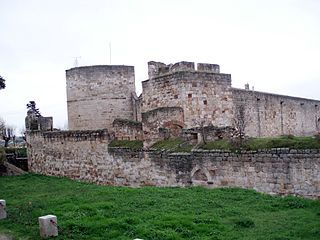 W
WThe Battle of Las Babias occurred in the year 795 when the Emir of Cordoba, Hisham I of Córdoba sought to avenge his previous military incursions in 794 against the Kingdom of Asturias under the command of the brothers Abd al-Karim ibn Abd al-Walid ibn Mugaith and Abd al-Malik ibn Abd al-Walid ibn Mugaith. The previous battles resulted in devastating losses for the Emirate, most importantly at the Battle of Lutos where one of the Emir's generals was killed in action. The battle resulted in a Córdoban victory.
 W
WThe Battle of Río Burbia or the Battle of the Burbia River was a battle fought in the year 791 between the troops of the Kingdom of Asturias, commanded by King Bermudo I of Asturias, and the troops of the Emirate of Córdoba, led by Yusuf ibn Bujt. The battle occurred in the context of the Ghazws of Hisham I against the Christian rebels of the northern Iberian Peninsula. The battle took place near the Río Burbia, in the area which is today known as Villafranca del Bierzo. The battle resulted in a victory for the Emirate of Cordoba.
 W
WThe Battle of Clavijo is a mythical battle. "To a serious historian, the existence of the Battle of Clavijo is not even a topic of discussion". However, it was believed for centuries to be historical, and it became a popular theme of Spanish traditions regarding the Christian expulsion of the Muslims. The stories about the battle are first found centuries after it allegedly occurred; according to them, it was fought near Clavijo between Christians, led by Ramiro I of Asturias, and Muslims, led by the Emir of Córdoba.
 W
WThe Day of Zamora, also known as Jornada del Foso de Zamora, was a battle of the Spanish Reconquista that took place at the city of Zamora, Spain The battle was fought between the forces of the Kingdom of Asturias under the command of Alfonso III of Asturias and the Muslim forces of Ahmed Ibn Muawiya, an Umayyad, who was also known as Ibn al-Qitt, and by his kunya: Abul Qassim. The battle ended with in victory for the city's defenders.
 W
WThe First Battle of Cellorigo was a battle that took place between the Kingdom of Asturias and the Emirate of Córdoba over the castle at Cellorigo and its surrounding countryside in 882.
 W
WThe Battle of Guadalacete was fought in 852 between a coalition of troops from the Kingdom of Asturias and the Kingdom of Navarre, and a force of troops from the Muslim Emirate of Córdoba under the command of Muhammad I of Córdoba. The outcome was a Muslim victory.
 W
WThe Battle of Lutos occurred in the year 794 when the Emir of Cordoba, Hisham I of Córdoba, sent military incursions against the Kingdom of Asturias under the command of the brothers Abd al-Karim ibn Abd al-Walid ibn Mugaith and Abd al-Malik ibn Abd al-Walid ibn Mugaith.
 W
WThe Battle of Pancorbo was a battle that took place in the year 816 between a Moorish army from the Emirate of Cordoba sent by Al-Hakam I and under the control of Abd al-Karim ibn Abd al-Wahid ibn Mugit and the pro-Frankish forces under the control of Balask al-Yalasqi. The battle was fought when the Córdoban forces attempted to cross the pass at Pancorbo.
 W
WThe Raid of 897 was a military campaign of the Emirate of Cordova against the County of Barcelona.
 W
WThe Raid of 904 was a military campaign of the Emirate of Cordova against the counties of Pallars and Ribagorza.
 W
WThe Second Battle of Cellorigo took place between the Emirate of Córdoba over the castle at Cellorigo and its surrounding countryside in 883 AD.
 W
WThe Battle of the Morcuera, was a battle of the Spanish Reconquista that took place in the Hoz de la Morcuera between the municipalities of Foncea and Bugedo nearby the city of Miranda de Ebro on 9 August, 865. The battle was fought between the combined Christian troops of the Kingdom of Castile and the Kingdom of Asturias under Rodrigo of Castile and the Muslim forces of the Emirate of Cordoba under Muhammad I of Córdoba. The battle resulted in a victory for the Cordobans and a general retreat in the overall Reconquista process.
 W
WViking activity in the Iberian peninsula seems to have begun around the mid-ninth century as an extension of Viking raids on and establishment of bases in Frankia in the earlier ninth century. While connections between the Norse and Eastern Islamic lands were well-established, particularly involving the Rus' along the Volga and around the Caspian Sea, relations with the Western edge of Islam were more sporadic and haphazard. Although Vikings may have over-wintered in Iberia, no evidence has been found for trading or settlement. Indeed, the Iberian peninsula may not have offered particularly wealthy targets, in the ninth to tenth centuries. Sporadic raiding continued until the end of the Viking Age.